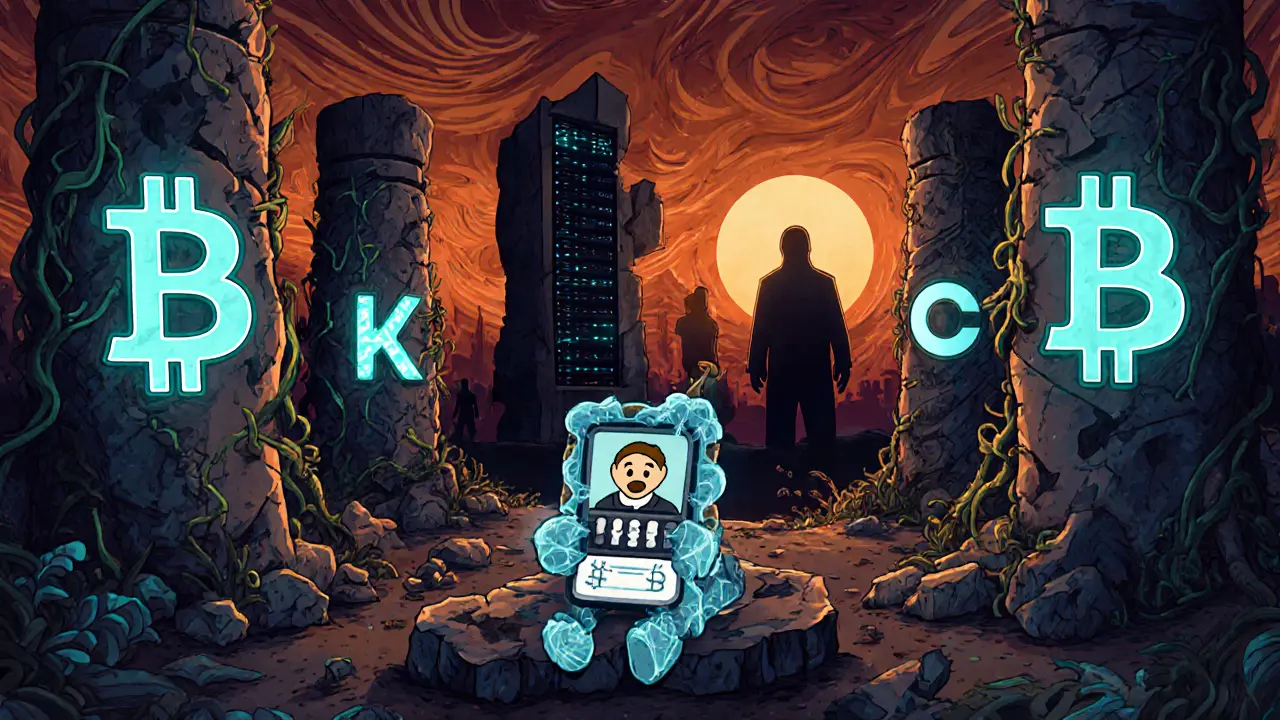Crypto Exchange Comparison Tool
Understand Why Bitlish Failed
This tool compares Bitlish's features (during its operation) with modern alternatives to show why it ultimately failed despite its strengths. Bitlish was known for transparency and low fees but lacked the scale needed for long-term survival.
Bitlish vs Modern Exchanges Comparison
| Feature | Bitlish (2018-2020) |
Kraken | Uphold | Coinbase | Bitpanda |
|---|---|---|---|---|---|
| Supported Fiat Currencies | EUR, GBP, RUB, JPY, USD | 14+ currencies | 30+ currencies | 15+ currencies | 15+ currencies |
| Supported Cryptocurrencies | 13 | 100+ | 30+ | 80+ | 40+ |
| Fee Structure | 0% (market makers) 0.5% (market takers) |
0.16% - 0.26% fee | 0.25% - 0.5% fee | 0.5% - 1.49% fee | 0.3% - 0.75% fee |
| Security Features | Cold storage, 2FA SSL encryption |
Cold storage, 2FA, multi-signature SSL encryption |
Cold storage, 2FA, multi-factor SSL encryption |
Cold storage, 2FA, multi-factor SSL encryption, FDIC-insured |
Cold storage, 2FA, multi-factor SSL encryption |
| Mobile App | Available (no updates after 2018) | Available | Available | Available | Available |
| Liquidity (Order Book Depth) | Low (thin order books) | High | High | High | High |
| User Verification | ID + utility bill (Fast, 24h) |
ID + address (24-72h) |
ID + address (15-30 min) |
ID + address (5-15 min) |
ID + address (15-30 min) |
Why Bitlish Failed: Key Takeaways
- Insufficient user base (under 50,000 active users)
- Low trading volume leading to thin order books
- Lack of funding for growth during crypto winter
- Unable to compete with larger exchanges' liquidity and features
While Bitlish had strong security and transparent fees, exchanges need sufficient liquidity to provide good trading experiences. Low user volume creates poor order books, which drives away serious traders. Without funding to grow during downturns, exchanges become vulnerable to collapse.
Bitlish was once a quiet player in the crypto exchange world - not as loud as Binance, not as big as Coinbase - but it had something most exchanges didn’t: transparency. If you traded crypto for euros, pounds, or rubles back in 2018, Bitlish made it simple. No hidden fees. No confusing tiers. Just clear pricing. But here’s the hard truth: Bitlish is dead. It stopped operating on March 30, 2020. No warning. No final message. Just silence.
What Bitlish Actually Offered
Bitlish wasn’t trying to be everything. It focused on one thing: helping people buy crypto with real money. It supported five fiat currencies - EUR, GBP, RUB, JPY, and USD - and let you trade them directly against USDT. That was rare. Most exchanges made you first buy Bitcoin, then trade it for altcoins. Bitlish let you skip the middleman.
It supported 13 cryptocurrencies: Bitcoin, Ethereum, Litecoin, Dash, Monero, Ripple, Zcash, Bitcoin Cash, Bitcoin Gold, IOTA, Dogecoin, HBZ, and EOS. NEM was dropped in 2019. That’s not a lot compared to today’s exchanges with hundreds of coins, but back then, it was enough for most users in Europe and Russia.
The platform had a clean, no-frills interface. No margin trading. No futures. No leverage. Just market, limit, and time-limit orders. If you wanted to buy Bitcoin with your debit card and hold it, Bitlish worked. If you wanted to day trade with 10x leverage, you’d need to go elsewhere.
How Bitlish Stayed Secure
For a smaller exchange, Bitlish took security seriously. Most of its crypto funds were stored in offline cold wallets. Fiat money sat in segregated bank accounts - separate from company operating funds. That’s a basic but vital practice many exchanges still skip today.
Two-factor authentication (2FA) was mandatory. All API connections used SSL encryption. The backend ran on a WebSocket API built with Asyncio, and response times averaged 198 milliseconds - faster than Poloniex and bitFlyer at the time. They also had 24/7 anti-fraud monitoring.
They even offered mobile apps for iOS and Android. Not flashy, but functional. And support was available 24/7 in 14 languages, including Russian, French, Spanish, and Chinese - which made sense given their main user base.
Fees: The One Thing Everyone Praised
Bitlish’s fee structure was its biggest selling point. Market makers - people who added liquidity by placing limit orders - paid 0% fees. Market takers - those who bought or sold instantly at market price - paid 0.5%. That was low, especially compared to exchanges charging 0.75% to 1.5%.
And unlike most platforms, Bitlish didn’t hide fees. Every charge was listed clearly. Deposit fees via credit card were among the lowest in the industry. Withdrawals via bank transfer (SEPA, SWIFT), Skrill, or Neteller were straightforward. No surprise charges. No “processing fees” tacked on at the end.
ForexSQ called it “the most transparent fee model in the space.” And users noticed. Many praised it for being fair and predictable.

Why Bitlish Failed
Transparency and low fees don’t save you if you don’t have enough users.
Bitlish never cracked the 50,000 active user mark. By 2019, its trading volume was a fraction of Kraken’s or Binance’s. That meant thin order books. If you wanted to sell 10 BTC, you’d wait. Or get a bad price. That drove away serious traders.
It also didn’t have the funding to grow. While bigger exchanges raised millions in Series A rounds, Bitlish stayed small. No VC backing. No marketing budget. No influencer campaigns. Just word of mouth.
And then came the 2019-2020 crypto winter. Prices dropped. Trading slowed. Exchanges with weak liquidity started collapsing. Bitlish was one of them. According to CoinDesk’s 2021 post-mortem, it “failed to secure funding during the downturn.” Revain’s user reviews echoed this: “low volume and lack of control.”
Even worse, it couldn’t compete with new players. By 2020, exchanges like Kraken and Uphold offered the same fiat-on-ramp services with better liquidity, more coins, and stronger reputations.
The Scam Allegations
Not every review was positive. Bitcointalk threads from May 2021 detailed claims of users being locked out of their accounts. One user wrote: “They took my money and refused to pay back.” Rates.Guru had a headline: “Go far away from this scam exchange!!”
But here’s the twist: these complaints came after the exchange had already shut down. Users who were still trying to withdraw after March 30, 2020, were hitting a wall. The site was gone. The support team vanished. The company disappeared.
Was Bitlish a scam? Maybe not when it was running. But when it shut down without notice - and without refunding users who had pending withdrawals - it looked exactly like one. That’s the cruel irony: a platform praised for honesty ended in betrayal.
What Users Loved - and Hated
Positive feedback focused on:
- Easy fiat deposits with cards, Skrill, or bank transfer
- Fast verification (ID + utility bill)
- Simple interface - good for beginners
- Low fees and clear pricing
- Good customer service - while it lasted
Negative feedback centered on:
- Limited coin selection
- Thin order books for altcoins
- Withdrawal delays in the final months
- No mobile app updates after 2018
- Complete disappearance after shutdown
One user on Bestchange said: “Been trading here for half a year and still have no trouble.” Another, on Bitcointalk, said: “They were polite when taking money - cruel when you asked for it back.”

Was Bitlish Legit?
Yes - while it was open. It had SSL, cold storage, 2FA, and audited security practices. It was registered in the UK (though some sources said Russia). It didn’t have a license, but neither did many small exchanges back then.
But legitimacy isn’t just about tech. It’s about reliability. When a company vanishes and leaves users stranded, it breaks trust. Even if everything was above board before, the end result was the same: people lost access to their funds.
What Replaced Bitlish
Today, if you want to buy crypto with euros or pounds, you have better options:
- Kraken - Lower fees, more coins, better liquidity, regulated in multiple countries
- Uphold - Direct fiat-to-crypto, supports 30+ assets, strong mobile app
- Coinbase - Easy for beginners, insured custodial storage, US/EU regulated
- Bitpanda - Great for European users, low deposit minimums, EU-based
All of these offer what Bitlish did - plus more coins, deeper markets, and active customer support.
The Legacy of Bitlish
Bitlish didn’t fail because it was badly built. It failed because it was too small, too quiet, and too dependent on a niche market. It had the tech. It had the trust. But it didn’t have the scale.
Its story is now a textbook case in academic papers like the University of Cambridge’s 2022 study, “Why Cryptocurrency Exchanges Fail.” It’s used to show how even technically sound platforms can collapse without funding, liquidity, or growth strategy.
Bitlish’s API was fast. Its fees were fair. Its interface was clean. But in crypto, speed and fairness aren’t enough. You need volume. You need trust. And you need to stay alive long enough for users to believe you’ll be there tomorrow.
Bitlish isn’t around to answer that question anymore. But its history is a warning: in crypto, quiet doesn’t mean safe. It just means invisible - until it’s gone.
Is Bitlish still operating in 2025?
No, Bitlish ceased all operations on March 30, 2020. Its website is offline, its support channels are dead, and there have been no revival attempts since. Any site claiming to be Bitlish today is a scam or clone.
Can I recover my funds from Bitlish?
No. Since the exchange shut down without notice and disappeared completely, there is no way to access accounts or withdraw funds. Users who tried to withdraw after March 2020 were unable to do so. Any promises of fund recovery are fraudulent.
Was Bitlish a scam?
While Bitlish operated transparently during its active years - with clear fees, cold storage, and verified security - its abrupt shutdown without refunding users created the appearance of a scam. Many users lost access to their funds, and the company vanished. Legally, it may not have been fraudulent from the start, but its end behavior matches scam patterns.
What cryptocurrencies did Bitlish support?
Bitlish supported 13 cryptocurrencies: Bitcoin (BTC), Ethereum (ETH), Litecoin (LTC), Dash (DASH), Monero (XMR), Ripple (XRP), Zcash (ZEC), Bitcoin Cash (BCH), Bitcoin Gold (BTG), IOTA (IOTA), Dogecoin (XDG), HBZ, and EOS. NEM was delisted in July 2019.
Did Bitlish have a mobile app?
Yes, Bitlish had official mobile apps for both iOS and Android. They were functional and received positive feedback for usability. However, no updates were released after 2018, and the apps no longer work since the platform shut down.
What were Bitlish’s fees?
Bitlish charged 0% for market makers (limit orders) and 0.5% for market takers (instant buys/sells). Deposit fees via card were among the lowest in the industry. Withdrawal fees varied by method but were clearly listed. No hidden charges.
Why did Bitlish shut down?
Bitlish shut down due to low trading volume and lack of funding. It couldn’t compete with larger exchanges during the 2019-2020 crypto market downturn. Despite a solid technical foundation, it failed to attract enough users or secure Series A investment. Industry reports cite “insufficient liquidity” and “lack of control” as primary causes.
Which countries could use Bitlish?
Bitlish served users in Europe and Russian-speaking regions. It blocked residents of 19 countries, including the United States, Iran, North Korea, and China. Its focus was on users who wanted to trade fiat (EUR, GBP, RUB) for crypto without complex procedures.











13 Comments
Bitlish was the quiet guy at the party who actually remembered your name. No hype, no flashy charts, just clean execution. It’s sad how the system rewards noise over substance. We built crypto to be decentralized, but we ended up worshiping the loudest voices. The real tragedy isn’t that Bitlish died-it’s that we didn’t care enough to keep it alive.
Oh wow. A crypto exchange that didn’t charge you $50 to withdraw $20? How quaint. Next they’ll tell you the moon is made of cheese and the CEO still uses a flip phone.
Bitlish didn’t fail because it was bad. It failed because it was honest in a world that rewards manipulation. Most exchanges today are glorified casinos with KYC forms. Bitlish was a tool. Simple. Reliable. Transparent. We didn’t need more coins or leverage-we needed more platforms like this. Instead, we got influencers selling memecoins and VC-funded Ponzi schemes disguised as ‘DeFi.’
It is imperative to note that the abrupt cessation of operations, coupled with the complete erasure of digital presence, aligns with known patterns of state-sponsored asset seizure. The timing coincides with the UK’s Financial Conduct Authority’s intensified scrutiny of unlicensed fiat-on-ramp platforms. One must consider whether the disappearance was voluntary-or coerced. The lack of public documentation from regulatory bodies is itself suspicious.
I used Bitlish back in 2019 to buy my first Bitcoin with my debit card. It was the first time I ever felt like a real investor instead of a gambler. The interface was so clean, I didn’t need a tutorial. I still remember how relieved I was to see exactly what I was paying-no sneaky fees, no fine print. It’s a shame the industry moved away from that kind of integrity.
THEY WERE NEVER REAL. I KNEW IT. 🤫 The cold wallets? Fake. The 2FA? A placebo. The ‘support’? A bot farm run out of a basement in Minsk. They drained accounts slowly-first the small ones, then the big ones. When the market crashed, they just pulled the plug and vanished. I’m not mad. I’m just… disappointed. 😔
Look, if you’re from Europe and you’re crying about Bitlish, you’re part of the problem. We don’t need some half-baked European exchange with 13 coins. America built this industry. If you couldn’t compete with Coinbase or Kraken, you deserved to die. Stop romanticizing failure.
Bitlish’s story is a powerful reminder that technology alone cannot sustain a platform. Trust, liquidity, and scalability are interdependent. Without a clear path to growth, even the most ethically designed systems collapse under market pressure. This is not a failure of ethics-it is a failure of economics. We must design for sustainability, not just integrity.
How adorable. A tiny exchange with ‘transparent fees’? How 2017. The real winners are the ones who scaled, raised billions, and made crypto mainstream. Bitlish was a cute footnote. A relic. Like dial-up internet with a side of idealism. We don’t need ‘fair’-we need dominant.
Wait-so you’re saying… they didn’t charge 1.5%? And… they had cold storage? And… they didn’t disappear until after the crash? That’s… that’s not possible. I mean-come on. You’re telling me someone actually did things right? And still went under? That’s… that’s… insane. That’s not how this works. That’s not how ANY of this works.
bro bitlish was lit af!! i used it for xmr and doge back in 2019 n the withdrawl was fast!! but after 2020 no reply from supprt and my funds gone!! i think it was rug pull by the devs!! they were from russia and they just took the money and ran!! 😭
Okay so imagine this: you're scrolling through your phone at 2 a.m., you just bought your first Bitcoin on Bitlish, you're high on hope and cheap coffee, and you think, ‘I’m part of the future.’ Then one day, the app just… stops. No email. No tweet. No ‘We’re shutting down.’ Just… silence. Like your ex ghosted you after you gave them your heart, your ID, and your life savings. And now? You’re sitting there wondering if the whole thing was a dream. I still check the website every month. I don’t know why. I just… need to see if it’s still there. It’s not. But I still check.
Bitlish didn’t need to be big to be good. It just needed to be allowed to exist. The fact that it disappeared without a trace says more about our industry than any whitepaper ever could. We built a system that punishes honesty. We reward hype, not hardware. We cheer for scale, not security. Let’s not forget Bitlish-not because it was perfect, but because it reminded us what crypto was supposed to be: open, fair, and user-first.